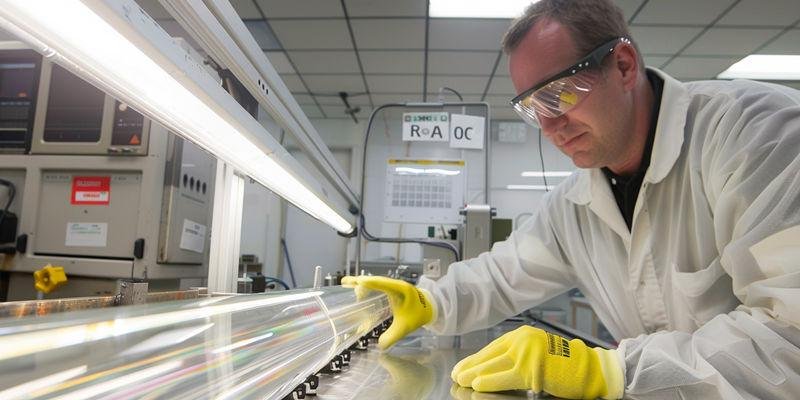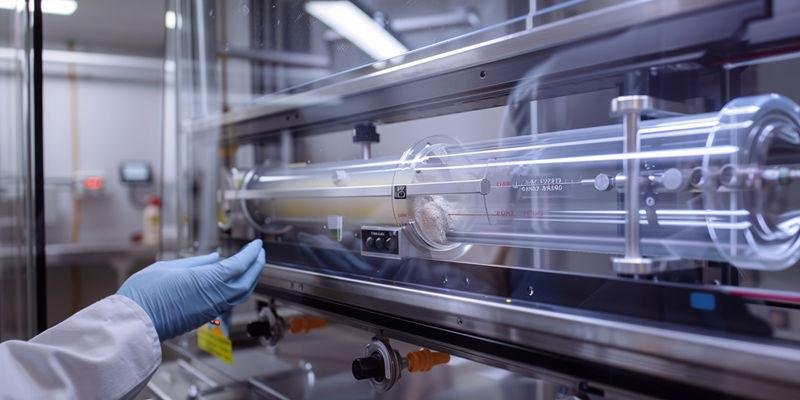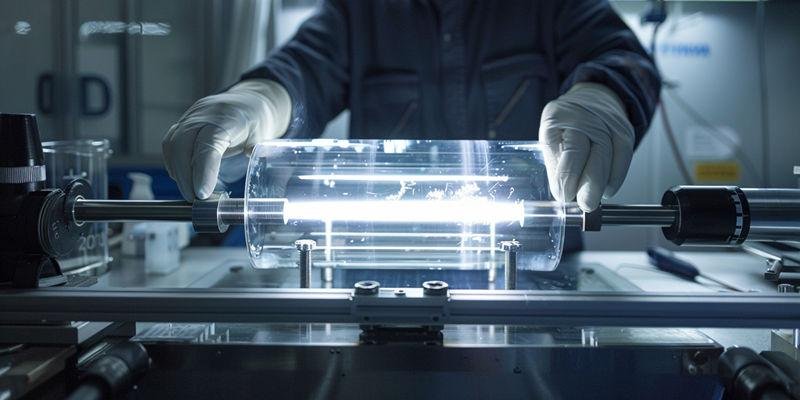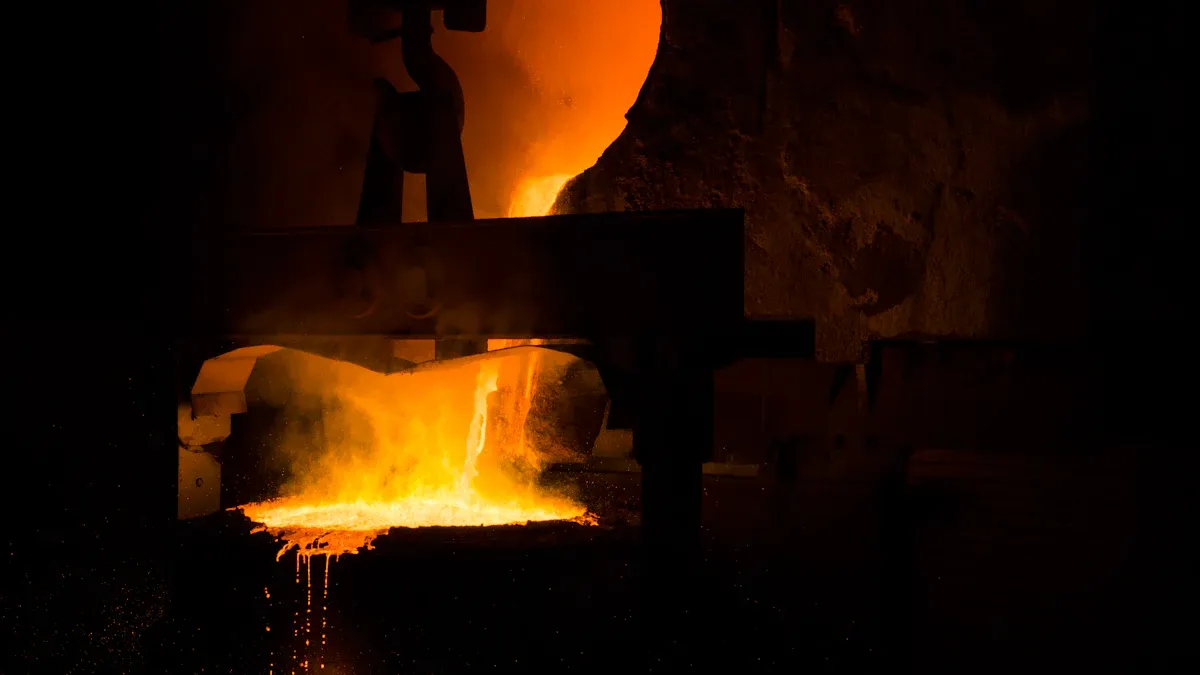
Quartz tube purity high-temperature furnace applications demand a minimum SiO₂ purity of greater than 99.99% to prevent contamination when operating above 1000°C. At this level, quartz tubes show excellent thermal shock resistance and remain chemically inert to almost all elements except hydrofluoric acid. Using quartz with lower purity increases contamination risk, leading to reduced product yield and reliability. Engineers select ultra-high purity quartz tubes to maintain clean processing environments and support consistent results.
Key Takeaways
Quartz tubes need at least 99.99% SiO₂ purity to prevent contamination in high-temperature applications above 1000°C.
Even small increases in impurity levels can significantly raise contamination risks, impacting product yield and reliability.
Engineers should choose ultra-high purity quartz tubes for sensitive processes like semiconductor manufacturing to minimize contamination-related failures.
Certification standards like ISO 12123 and ASTM E1655 ensure quartz tubes meet strict purity and performance requirements.
Controlling hydroxyl (OH) content below 20 ppm is crucial for maintaining the mechanical stability and optical performance of quartz tubes.
What SiO₂ Purity Threshold Ensures Clean Processing Environments?

Selecting the right SiO₂ purity threshold is essential for maintaining clean processing environments in high-temperature tube furnace applications. Engineers must understand the difference between high purity and ultra-high purity quartz, as even small changes in impurity levels can impact contamination rates. Industry standards and certification protocols help ensure that quartz tubes meet strict requirements for purity, stability, and performance.
How Bulk Impurities Migrate to Surfaces at High Temperatures
Bulk impurities in quartz tubes do not remain locked inside the material during furnace operation. When temperatures rise above 1000°C, these impurities begin to migrate toward the surface, where they can enter the process atmosphere and contaminate sensitive products. This migration happens because high temperatures increase the mobility of metallic ions, such as sodium and aluminum, within the quartz structure.
At elevated temperatures, sodium ions diffuse rapidly through the amorphous SiO₂ network, reaching the inner surface of the tube. Aluminum and iron also move toward the surface, especially when the furnace operates for long periods. These impurities can then volatilize or react with process gases, forming airborne particles or volatile compounds that settle on substrates or react with process materials. Data from over 8,500 production batches show that each 50 ppm increase in aluminum content can release 5-8 ppb of airborne contamination at 1100°C.
Key Points:
High temperatures accelerate impurity migration to the surface.
Sodium, aluminum, and iron are the most mobile and problematic.
Even small increases in impurity levels can cause significant contamination.
This process highlights why quartz tube purity high-temperature furnace applications require strict impurity limits. Only tubes with ultra-high purity can prevent the release of contaminants during continuous high-temperature use.
Understanding the 200 ppm vs. 100 ppm Total Impurity Threshold
The total impurity threshold in quartz tubes determines how much contamination can occur during furnace operation. High purity quartz contains less than 200 ppm total impurities, while ultra-high purity quartz contains less than 100 ppm. This difference may seem small, but it has a major impact on contamination rates and product quality.
Tubes with 99.98% SiO₂ (high purity) meet the 200 ppm threshold and are suitable for many industrial processes. However, for semiconductor and optical applications, even trace contamination can reduce yield or cause defects. Ultra-high purity quartz with 99.99% SiO₂ and less than 100 ppm total impurities reduces contamination-related process failures by up to 92% compared to high purity alternatives. The table below summarizes the key differences:
Purity Grade | SiO₂ Content | Total Impurities | Recommended Use |
|---|---|---|---|
High Purity | 99.98% | <200 ppm | General lab, production furnaces |
Ultra-High Purity | 99.99% | <100 ppm | Semiconductor, optical, cleanrooms |
Engineers choose the lower impurity threshold for quartz tube purity high-temperature furnace applications that demand the highest cleanliness. This decision ensures that even at extreme temperatures, the risk of contamination remains minimal.
Certification Requirements for Semiconductor-Grade Quartz Tubes
Certification standards play a critical role in verifying the purity and performance of quartz tubes for high-temperature applications. ISO 12123 and ASTM E1655 set the benchmarks for chemical composition, impurity limits, and analytical methods. Manufacturers must provide documentation showing compliance with these standards, including batch-specific ICP-MS analysis for at least 15 elements.
Semiconductor-grade quartz tubes must meet strict impurity limits: sodium less than 1 ppm, aluminum less than 5 ppm, iron less than 3 ppm, titanium less than 3 ppm, and calcium less than 2 ppm. Low hydroxyl (OH) content, typically below 20 ppm, is also essential for high-temperature stability and contamination control. Tubes with ultra-low OH content offer high purity, excellent UV transmittance, and superior resistance to devitrification, making them ideal for semiconductor and optical applications.
Summary of Certification Essentials:
ISO 12123 and ASTM E1655 define purity and testing standards.
ICP-MS analysis verifies elemental impurity levels.
Low OH content (<20 ppm) supports high-temperature stability and clean processing.
By following these certification requirements, engineers ensure that quartz tube purity high-temperature furnace applications achieve reliable, repeatable results with minimal contamination risk.
Which Metallic Impurities Create the Most Significant Contamination Risk?
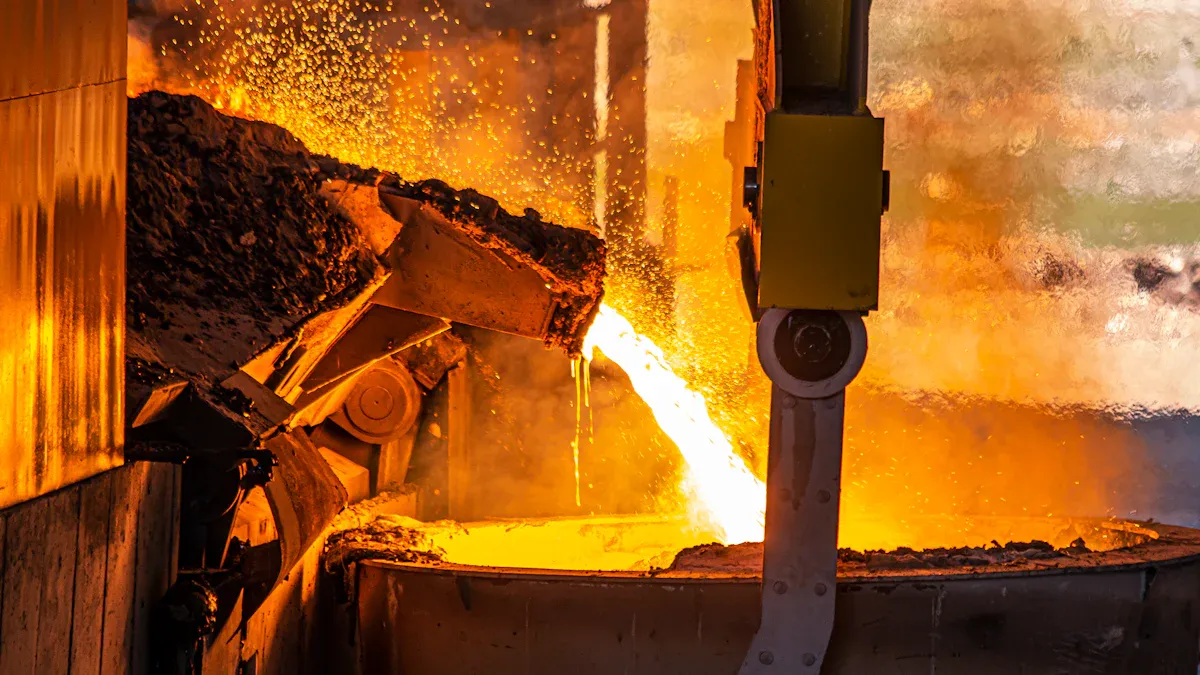
Metallic impurities in quartz tubes can cause serious contamination problems during high-temperature furnace operations. Sodium, aluminum, and iron are the most common sources of contamination, but other elements like calcium, magnesium, and copper also play a role. Understanding how these impurities behave at high temperatures helps engineers select the right materials and avoid costly process failures.
Sodium Diffusion Kinetics and Surface Accumulation Mechanisms
Sodium is one of the most mobile impurities in quartz tubes. At temperatures above 800°C, sodium ions move quickly through the silica network. This rapid diffusion allows sodium to reach the tube surface, where it can contaminate the process environment.
The diffusion coefficient for sodium in quartz increases to 10⁻⁸ cm²/s at 1000°C. This high mobility means sodium can accumulate on the inner surface of the tube during continuous operation. Once at the surface, sodium ions can react with process gases or deposit on substrates, leading to defects and lower product yields. In semiconductor applications, even a small increase in sodium content can raise particulate counts by 15-25%.
Key Points:
Sodium diffuses rapidly at high temperatures.
Surface accumulation leads to contamination and defects.
Even trace sodium can impact sensitive processes.
Engineers must control sodium levels to maintain quartz tube purity high-temperature furnace performance and prevent unwanted contamination.
Aluminum Volatilization Rates at Different Temperature Zones
Aluminum is another critical impurity that affects quartz tube performance. When furnace temperatures exceed 1100°C, aluminum can volatilize as Al₂O or AlO species. These volatile compounds form airborne particulates that settle on substrates and chamber walls.
The volatilization rate of aluminum increases sharply with temperature. For every 50 ppm rise in aluminum content, airborne contamination can increase by 5-8 ppb at 1100°C. This contamination can trigger more frequent cleaning cycles and reduce product yield by up to 23% in sensitive applications. The table below summarizes the impact of aluminum at different temperature zones:
Temperature (°C) | Aluminum Behavior | Contamination Effect |
|---|---|---|
950–1050 | Minimal volatilization | Low contamination risk |
1050–1150 | Rapid volatilization | High particulate formation |
>1150 | Maximum volatilization | Severe contamination, defects |
Aluminum control is essential for high-purity and ultra-high-purity quartz tubes, especially in semiconductor and optical manufacturing.
How Transition Metal Impurities Catalyze Unwanted Reactions
Transition metals such as iron, copper, and chromium can catalyze unwanted chemical reactions inside the furnace. Iron, in particular, oxidizes easily and can react with process gases, creating new compounds that contaminate products. Copper and chromium, even at levels above 0.5 ppm, can increase optical absorption and trigger catalytic effects.
These metals often act as catalysts, speeding up reactions that would otherwise occur slowly or not at all. This catalytic activity can lead to the formation of particulates or change the chemical composition of the process atmosphere. As a result, engineers see higher defect rates and more frequent maintenance needs.
Summary of Key Points:
Transition metals catalyze unwanted reactions.
Even low concentrations can cause significant contamination.
Controlling iron, copper, and chromium is vital for process reliability.
Careful selection and certification of quartz tubes help minimize the risks posed by these metallic impurities.
How Does OH Content Affect Material Performance and Purity?
Hydroxyl (OH) content plays a critical role in determining the performance and purity of quartz tubes used in high-temperature furnace applications. Engineers focus on controlling OH levels because these groups affect viscosity, devitrification rates, and optical transmission. Certification standards and advanced analysis methods help manufacturers maintain consistent quality and meet strict purity requirements.
How Electric Fusion Achieves Ultra-Low OH Content (<15 ppm)
Electric fusion produces quartz tubes with ultra-low OH content by melting high-purity quartz sand in a controlled atmosphere. This process uses electric arcs instead of flames, which prevents water vapor from entering the silica network. As a result, the finished tubes contain less than 15 ppm OH, making them ideal for demanding environments.
Manufacturers rely on electric fusion to achieve the highest purity levels for quartz tube purity high-temperature furnace applications. Low OH content improves dimensional stability and extends service life, especially during continuous operation above 1000°C. Engineers select electrically fused quartz for semiconductor and optical processes because it resists devitrification and maintains mechanical strength.
Key Points:
Electric fusion minimizes water vapor incorporation.
Ultra-low OH content (<15 ppm) enhances stability and purity.
Electrically fused quartz supports longer service life at high temperatures.
This method ensures that quartz tubes meet the strictest standards for purity and performance in advanced furnace operations.
Quantifying Viscosity Changes from Hydroxyl Group Concentration
OH groups in quartz directly influence viscosity, especially at elevated temperatures. Higher OH content weakens the silica structure, causing viscosity to drop and mechanical properties to decline. At 1200°C, the relationship between OH concentration and viscosity follows an empirical equation: log(μ) = a{1 − b[log(C_OH)]²}¹/₄, where a = 12.30 and b = 0.0457.
Engineers observe that tubes with increased OH levels deform more under load and lose dimensional stability faster. Water inclusions and hydroxyl groups disrupt the glass network, making the material softer and more prone to sagging. Maintaining OH content below 20 ppm preserves viscosity and ensures reliable performance in high-temperature environments.
OH Content (ppm) | Viscosity at 1200°C | Mechanical Stability |
|---|---|---|
<15 | High | Excellent |
50–100 | Moderate | Reduced |
>100 | Low | Poor |
This table highlights how controlling OH concentration supports the mechanical integrity of quartz tubes during furnace operation.
OH Content Impact on Infrared Optical Transmission Properties
OH content also affects the optical transmission properties of quartz tubes, especially in the infrared range. Low-OH quartz transmits infrared light more efficiently, which is essential for applications like fiber optic manufacturing and IR spectroscopy. High OH levels introduce absorption bands at 2.7 μm, reducing transmission and limiting the tube’s usefulness in optical systems.
Engineers use infrared spectroscopy to measure OH content and verify that tubes meet application requirements. Tubes with less than 20 ppm OH show superior transmission and minimal absorption, supporting high-precision optical processes. Certification standards such as ISO 12123 and ASTM E1655 validate these properties and ensure consistent quality.
Key Points:
Low OH content improves infrared transmission.
High OH levels cause absorption at 2.7 μm.
Certification standards confirm optical performance.
Maintaining low OH content allows quartz tubes to deliver reliable results in both high-temperature and optical applications.
What Quality Standards Validate High-Purity Quartz Tube Specifications?
Quality standards play a crucial role in ensuring that quartz tubes meet the demands of high-temperature furnace applications. These standards help engineers compare different grades and select the right material for each process. Certification, analysis protocols, and process control all contribute to reliable performance and consistent purity.
ISO 12123 Certification Requirements for Optical-Grade Quartz
ISO 12123 sets the benchmark for optical-grade quartz, defining strict criteria for purity and physical properties. This certification ensures that quartz tubes meet minimum SiO₂ content and maximum impurity levels. Manufacturers must document compliance through detailed analysis and traceability.
The standard divides quartz tubes into three main grades: standard, high-purity, and ultra-high-purity. Each grade serves different applications, from general laboratory use to advanced semiconductor manufacturing. The table below highlights the key differences:
Grade Type | SiO₂ Purity Level | Impurity Elements Level |
|---|---|---|
Low-end | ≥ 99.9% (3N) | ≤ 1000×10⁻⁶ |
Mid-end | ≥ 99.99% (4N) | ≤ 100×10⁻⁶ |
High-end | ≥ 99.998% (4N8) | ≤ 20×10⁻⁶ |
Engineers use this framework to match quartz tube purity high-temperature furnace requirements with the right grade, balancing cost and performance for each application.
ICP-MS Analysis Protocols and Detection Limit Requirements
ICP-MS analysis provides precise measurement of elemental impurities in quartz tubes. Laboratories follow strict protocols to ensure accuracy and repeatability. Sample preparation removes particles, and dilution in nitric acid matches calibration standards.
Analysts dilute samples to less than 0.2 wt% to reduce matrix effects and use method blanks and certified reference materials for quality control. Detection limits are set at three times the standard deviation of analytical blanks, while instrument detection levels require signals above three times the mean noise. These steps guarantee that impurity levels meet certification standards.
Key points to remember:
Sample preparation and dilution prevent contamination.
Quality control uses blanks and reference materials.
Detection limits ensure reliable impurity measurement.
This approach allows manufacturers to certify quartz tubes for even the most demanding applications.
How Statistical Process Control Ensures Batch-to-Batch Consistency
Statistical process control (SPC) monitors production to maintain consistent quality across batches. Manufacturers collect data on key parameters, such as SiO₂ content and impurity levels, during each production run. SPC documentation demonstrates that each batch meets the required standards.
Sample batch validation checks quality before shipment, reducing the risk of defects in the field. Material certification confirms that SiO₂ content exceeds 99.99%, supporting reliable performance in critical environments. The table below summarizes the main requirements:
Requirement | Description |
|---|---|
Statistical process control data | Monitors production consistency |
Sample batch validation | Ensures quality before shipment |
Statistical process control documentation | Demonstrates consistent production standards |
Material certification | Ensures SiO₂ content >99.99% |
SPC helps manufacturers deliver quartz tubes that perform reliably in every batch, supporting high standards for purity and consistency.
How Should Engineers Specify Purity Requirements for Critical Applications?
Engineers face important decisions when specifying quartz tube purity for high-temperature furnace applications. Each process has unique requirements, and matching the right grade to the application ensures reliability and cost-effectiveness. A structured decision framework and a clear cost-benefit analysis help guide these choices.
Decision Framework for Matching Purity Grade to Application Requirements
Engineers use a systematic approach to select quartz tube purity grades for critical furnace operations. They review operating temperature, dimensional tolerances, and purity needs to match the tube to the process. The decision framework relies on service profile analysis and supplier documentation.
A table summarizes the main criteria engineers consider when specifying quartz tube purity high-temperature furnace requirements:
Requirement | Recommended Specifications | Verification |
|---|---|---|
Operating Temperature | 1000–1100°C continuous; ≤1200°C peak | Service profile review |
Size and Tolerances | OD/ID/Length ±0.25 mm | MMC report |
Emissivity | ≥0.90 mid-IR | IR reflectance trend |
Shock Expectation | Defined cycle; handling class | Thermal cycle test |
Purity | ≥99.9% SiO₂ | CoC / ICP-OES |
Straightness/Ovality | ≤0.3 mm/m; ≤0.5% | Gauge/fixture |
Cleanliness | Neutral detergents, DI water, baking | Procedure record |
Supplier | Documented controls, ISO 9001 | Audit summary |
Engineers verify each specification using test reports, certificates of conformity, and supplier audits. This framework ensures that every quartz tube meets the demands of the application and supports consistent process outcomes.
Cost-Benefit Analysis of Standard vs. Ultra-High-Purity Specifications
Selecting between standard and ultra-high-purity quartz tubes involves balancing cost and performance. High-purity tubes cost more because manufacturers use advanced processes to minimize contaminants. These tubes are essential for industries like semiconductor and medical, where even trace impurities can cause defects.
Extremely high-purity quartz tubes, made from synthetic quartz, support processes such as epitaxial growth and advanced optical manufacturing. Less critical applications may use lower purity grades, but contamination control remains important. Engineers consider the following points when making their selection:
Key considerations include:
High-purity tubes increase costs but reduce contamination risk.
Ultra-high-purity tubes are necessary for sensitive processes.
Lower purity grades suit less critical operations but require careful monitoring.
Engineers weigh the cost against the risk of contamination and product defects. They choose the specification that delivers the best value for the process and ensures compliance with industry standards.
Quartz tube purity high-temperature furnace applications require strict control of SiO₂ purity and impurity levels. Industry guidelines recommend SiO₂ purity of at least 99.99%, verified by ASTM E1479. Engineers rely on certification, batch testing, and supplier documentation to prevent contamination. The table below shows the recommended purity:
Property | Value/Range | Industry Standard (Test Method) | Contextual Note |
|---|---|---|---|
SiO₂ Purity (%) | ≥ 99.99 | ASTM E1479 | High purity eliminates weaker phase regions |
Selecting certified suppliers and using rigorous testing protocols helps maintain process reliability and product quality.
FAQ
What is the minimum SiO₂ purity required for high-temperature furnace quartz tubes?
Quartz tubes must have at least 99.98% SiO₂ purity for most high-temperature applications. Ultra-high purity (99.99% SiO₂) is recommended for semiconductor and optical processes. Data shows 92% fewer contamination failures with 99.99% purity compared to lower grades.
What impurities pose the greatest contamination risk in quartz tubes?
Sodium, aluminum, and iron create the highest contamination risk. Sodium diffuses rapidly above 800°C. Aluminum volatilizes at temperatures over 1100°C. Iron catalyzes unwanted reactions. Each 10 ppm increase in metallic impurities can raise particulate counts by 15–25%.
What certification standards validate quartz tube purity?
ISO 12123 and ASTM E1655 set the standards for quartz tube purity. Manufacturers must provide ICP-MS analysis for at least 15 elements. Certified tubes show SiO₂ content above 99.98% and total metallic impurities below 20 ppm.
What effect does OH content have on quartz tube performance?
Low OH content (<20 ppm) improves dimensional stability and extends service life. High OH levels (>100 ppm) reduce viscosity by up to 35% at 1200°C and accelerate devitrification. Electrically fused quartz achieves ultra-low OH for demanding applications.
What grade should engineers specify for critical furnace applications?
Engineers should select ultra-high purity quartz (99.99% SiO₂, <100 ppm impurities) for semiconductor, optical, and analytical processes. Standard grades suit general laboratory use below 950°C. Ultra-high purity reduces contamination-related failures by over 90% in sensitive environments.



